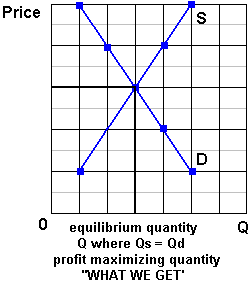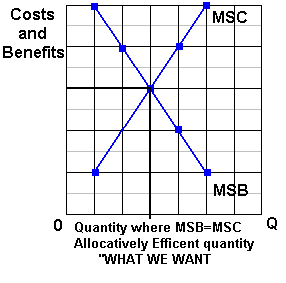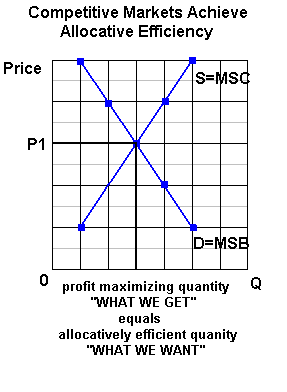See: The supply and demand model and allocative efficiency
1. WHAT WE GET:a. Goal of businesses: Maximize Profits
b. Therefore,they will produce where:
- the Market Equilibrium quantity
- the quantity where Qs=Qd
- the is "what we get"
- Graphically:
c. Assumptions: pure capitalism
2. WHAT WE WANT: ALLOCATIVE EFFICIENCY
a.. Review :(1) Allocative Efficiencydefinition - using our limited resources to produce:
- The quantity of goods and services that maximizes society's satisfaction
- using resources to produce more CDs that people want and fewer cassette tapes that they don't want
- no shortages and no surpluses
(2) Benefit-Cost Analysis
definition -the selection of ALL possible alternatives where the marginal benefits are greater than the marginal costselect all where: MB > MC
up to where: MB = MC
but never where: MB < MC
B. Allocative Efficiency is achieved where:
1. MSB=MSCa. define Marginal Social Benefits (MSB)b. define Marginal Social Costs (MSC)
c. therfore if society gets
all quantities where: MSB > MSC
up to where: MSB = MSC
but never where: MSB < MSCthis will be the quantity where society's Satisfaction will be maximized or the allocatively efficient quantity
2. Graphically:
C. THEREFORE:
1. Businesses will produce the profit maximizing or market equilibrium quantity - the quantity where Qd=Qs2. Society wants the allocatively efficient quantity - the quantity where MSB=MSC
3. WHAT WE GET = WHAT WE WANT if:
b. Market Demand = Marginal Social Benefits (D=MSB)1. law of diminishing marginal utility
2. assuming no spillover benefits D=MSBc. Market Supply = Marginal Social Costs (S=MSC)
1. law of increasing costs
2. assuming no spillover costs S=MSC
D. Competitive Markets and Allocative Efficiency (MSB=MSC)
1. if there are no spillover costs, then S = MSC,2. if there are no spillover benefits, then D = MSB,
3. Graphically:
4. Then: WHAT WE GET = WHAT WE WANT and market economies achieve allocative efficiency
In a market economy with no externalities:
- no positive externalities or spillover benefits
- no negative externalities or spillover costs
the profit maximizing or market equilibrium quantity
(what we get)WILL BE THE SAME AS
the allocative efficient quantity
(what we want)


